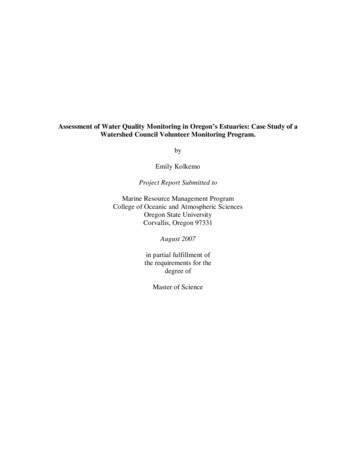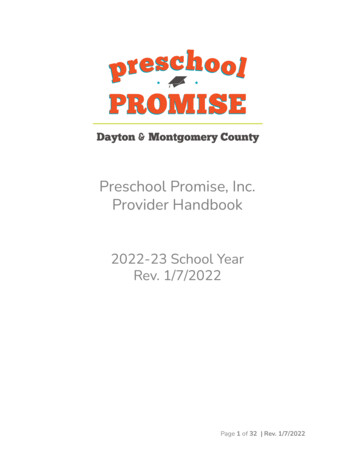
Transcription
Assessment of Water Quality Monitoring in Oregon’s Estuaries: Case Study of aWatershed Council Volunteer Monitoring Program.byEmily KolkemoProject Report Submitted toMarine Resource Management ProgramCollege of Oceanic and Atmospheric SciencesOregon State UniversityCorvallis, Oregon 97331August 2007in partial fulfillment ofthe requirements for thedegree ofMaster of Science
AcknowledgementsMany individuals and agencies have contributed to this project and to my degree. I want to thankall members and employees of the Siuslaw Watershed Council for giving me the opportunity toparticipate in the volunteer water quality monitoring project. I especially appreciate the effortsof all the volunteers that graciously donated their time and energy to the monitoring program.Many thanks to my committee members, Michael Harte, Steve Rumrill, and Courtland Smith,MRM staff, and the support of fellow MRM students for their assistance, time, and patience.Finally, thank you to my parents and grandmother, husband Jeff Jackson, and friends JanelBanks and Vickie Higgins for their continual support and encouragement.To my little Hawk, thank you for literally kicking me into action!
ABSTRACTThis project examined a watershed council sponsored volunteer estuary water quality monitoringprogram, from initial implementation to program status five years later. In addition, literatureresearch and interviews with estuarine experts were conducted in an attempt to devise strategiesto strengthen estuary water quality monitoring programs within the state of Oregon.I assisted in the implementation of the volunteer water quality monitoring program for awatershed council, then reviewed the current status of the program five years later. Based uponthis assessment, I found that the initial goals of the program had been met, but I also found thatthe program had been altered. While the goals of the program have stayed relatively the same,the way in which they are met has been changed to meet new objectives. This adaptivemanagement approach has allowed integration of the program within many watershed councilactivities, from educational endeavors to expanded monitoring within the upper watershed.Volunteers, from schoolchildren to adults, have been instrumental in collecting scientificallycredible data, and the program has been an effective tool to educate people of all ages aboutestuarine and water quality issues. While this particular program has been successful over thelong term, the estuarine component of the program has been de-emphasized. The reducedemphasis on the estuary may be due in part on limited funding for monitoring, and the difficultyassociated with assessing restoration needs (a major activity of watershed councils) based onestuarine water quality.Overall, a more coordinated approach needs to be taken with estuary water quality monitoring inOregon. While many different groups, such as watershed councils, should and can conduct actualfield monitoring activities, implementation and oversight should be coordinated through state,federal, tribal, private, and nonprofit entities that have an interest and role in Oregon’s estuaries.
TABLE OF CONTENTSINTRODUCTION1BACKGROUNDSiuslaw Watershed CouncilThe Siuslaw EstuaryHistory of the Water Quality Monitoring Program223METHODSProgram InitiationProgram EvaluationLiterature Research and Interviews478RESULTSProgram Status and AlterationsGoals Assessment913DISCUSSIONEvaluation of GoalsEffectiveness of VolunteersProgram TrendsProgram NDICESAppendix A: WorkplanAppendix B: Education and Recruitment Materials (presentation, brochure, flier)Appendix C: Quality Assurance Project PlanAppendix D: Siuslaw Estuary Water Quality Monitoring Sampling Procedures ManualAppendix E: Watershed Response QuestionnaireAppendix F: Strategies for Strengthening Water Quality Monitoring in Oregon Estuaries
LIST OF TABLES AND DIAGRAMSDIAGRAMSDiagram 1. Map of Siuslaw Estuary Water Quality Monitoring SitesTABLESTable 1: Siuslaw Estuary Water Quality Monitoring Program ComparisonTable 2: Siuslaw Volunteer Water Quality Monitoring Program Goals AssessmentTable 3: Recommendations to Improve Estuary Component of Water QualityMonitoring Program6101422
INTRODUCTIONMonitoring physical and biological processes within Oregon’s estuaries has become a higherpriority for scientific research and resource management planning in recent years. Watershedcouncils are expanding their activities into estuarine areas, especially in regards to assessment ofestuarine conditions, planning restoration activities, and to augment general watershed educationprograms. With the surge in activity, it is useful to examine the effectiveness of estuary-relatedprograms to determine possible future direction for estuarine efforts.As part of my internship for the Marine Resource Management program, I implemented avolunteer estuary water quality monitoring program for the Siuslaw Watershed Council from2002 to 2003 with guidance from the Siuslaw Watershed Council technical team and the OregonDepartment of Environmental Quality. The goals of the project were to educate the adjacentcommunity about estuarine issues and recruit and train volunteers to collect scientificallycredible data that various state and federal agencies could use to plan management activities inthe estuary.In 2007, I reviewed the current status of the program and performed a goals assessment based onthe activities and accomplishments of the program over the five-year period. Based upon some ofthe issues that arose from this particular monitoring program, I compiled a list ofrecommendations in order to devise a strategy for more coordinated and effective estuary waterquality monitoring within Oregon.The objectives of this report are to:1. Examine the methods used to initiate the estuary water quality monitoring program.2. Review changes to the program five years after implementation.3. Evaluate if and how goals of the program have been met.4. Provide recommendations for program improvement.5. Discusses effectiveness of the program and issues with estuary monitoring in Oregon.6. Provide recommendations for improvement of estuary monitoring in Oregon.1
BACKGROUNDSiuslaw Watershed CouncilThe Siuslaw Watershed Council is a nonprofit, volunteer organization that promotes watershedawareness and opportunities for people to participate in restoration. The mission of the council isto “support sound economic, social, and environmental uses of natural and human resources inthe Siuslaw Basin.” (Siuslaw Watershed Council, 2007)Watershed councils have proliferated in Oregon with the passage of House Bill 3441 in 1995 bythe Oregon Legislature, which provided guidance and funding for establishing councils. The billmandated that watershed councils be locally-controlled, voluntary, nonprofit, and non-regulatoryorganizations whose purpose is to restore and protect watershed health, with an emphasis onimproving native fish populations. Funding for watershed councils is provided primarily throughthe Oregon Watershed and Enhancement Board (OWEB), which awards on average 40 million infunds annually from Oregon lottery proceeds, license plate sales, federal salmon funds, andrevenue from “salmon-friendly” power purchases (OWEB, 2007).The Siuslaw EstuaryThe Siuslaw estuary is located midway on the Oregon Coast, and encompasses approximately4,200 acres and is the eighth largest estuary in the state of Oregon. The estuary portion ischaracterized as being relatively long and narrow, with the head of tide approximately 22 milesupriver (Ecotrust, 2002).The town of Florence is a major urban area on the lower regions of the estuary. Economicactivities that impact the estuary include tourism, recreational fishing, logging, development, andagriculture. Several threats to estuaries in Oregon have been identified, including excessivelevels of organic and inorganic nutrients, high water temperatures, hydrologic changes byphysical alteration, presence of toxic materials, and introduction of exotic species (Ecotrust,2002). Many of these threats are related to water quality, and have become a particular concernfor organizations working within estuaries.2
History of the Water Quality Monitoring ProgramThe Siuslaw Watershed Assessment, a document that guides council activities, listed waterquality as a particular concern in the Siuslaw estuary for three reasons: salmonid populationswere thought to be nutrient limited, the Florence sewage plant had several spills (before it wasupdated in 2001), and unusual algal blooms covering mudflat areas had been observed bylongtime local residents (Ecotrust, 2002). By the late 1990’s, comprehensive, long-term waterquality monitoring had not occurred on the Siuslaw estuary for 20 years. In that time, thelandscape had changed dramatically; Florence had grown as an urban center, restoration effortsexpanded in the upper watershed, and industry activity, such as logging, shifted from mostlypublic to private operations. The lack of information about the status of the estuary made itdifficult to plan and carry out projects in the estuary that were vital to salmon restoration andprotection. In response to these concerns and lack of information, the Siuslaw Estuary VolunteerWater Quality Monitoring Program was initiated in 1999 by the Siuslaw Watershed Council toaddress some of these potential water quality issues.The structure of the water quality monitoring program was to closely follow Siuslaw WatershedCouncil organization goals, which are to are to form partnerships with industries and agencies toimplement research and restoration efforts, provide educational opportunities for the council andthe community, and help landowners fund and carry out protection and restoration efforts ontheir land.The program was started in 2000 with some initial educational events, but failed to progressbeyond initial implementation. Information about this attempt is limited, because of personnelchanges and lack of documentation and data. In 2002, I accepted a position as monitoringcoordinator to re-start the program.3
METHODSThis project involved the initiation of a volunteer estuary water quality monitoring program andassessment of the program five years after implementation. In response to the findings, literatureresearch and interviews with estuarine experts were conducted to devise recommendations toimprove estuary water quality monitoring in Oregon.Program InitiationProgram initiation involved close coordination with the Siuslaw Watershed Council executivedirector and technical team. The first step was to develop a workplan (see Appendix A), whichinvolved investigation of similar programs, development of goals, site and monitoring parameterselection, and public outreach and volunteer recruitment.Investigation of similar programsInitially, eight other organizations that had water quality monitoring programs were contacted tosolicit advice and recommendations. These organizations included South Slough EstuarineResearch Reserve, Lower Columbia River Estuary Partnership, Tillamook Estuary Partnership,Long Tom Watershed Council, South Coast Watershed Council, Lower Columbia WatershedCouncil, Mid-Coast Watershed Council, and Sea Resources. Additional information and methodswere provided by OWEB in the Water Quality Monitoring Technical Guide Book and Coastnet’sSampling Procedures: A Manual for Estuary Monitoring.Development of goalsNext, a meeting with the Siuslaw Watershed technical team was arranged to disseminateinformation gathered from organization interviews and determine the overall program structure.From this meeting, the goals were established, type of monitoring program chosen, sites selected,and parameters and sampling schedule determined.The goals of the Siuslaw Estuary Volunteer Water Quality Monitoring Program were designed toclosely follow the overall goals of the Siuslaw Watershed Council. The resulting goals for theprogram were to:4
Educate the public about the connection between land use and water quality in theestuary. Establish a baseline of information for the estuary where no current water qualitymonitoring is occurring. Identify current and potential management needs and identify water quality issues. Provide information for resource and land managers to make decisions and developrestoration projects.Of the different types of water quality monitoring (baseline, effectiveness, and compliance), thetechnical team chose baseline monitoring, in order to characterize existing conditions. Tech teammembers agreed that a lack of water quality information was inhibiting understanding ofmanagement needs in the estuary, and baseline monitoring would fill in information gaps asidentified by the Siuslaw Watershed Assessment.Site and monitoring parameter selectionMonitoring sites were selected based on three criteria: public involvement, baseline monitoringdesign, and salmonid potential. Public considerations included convenience, access, and safety.In order to follow a baseline monitoring design, the tech team decided that the sites mustrepresent upper, middle, and lower zones within the estuary, should represent major contributingbodies of water, and provide an overview of overall conditions in a particular area. Salmonidpotential considerations included areas where restoration may occur, areas with potential habitatsuch as eelgrass beds and tidal marsh channels, and presence of tidegates. The resulting selectedsites are outlined in Diagram 1.5
Diagram 1. Map of Siuslaw estuary water quality monitoring sites.*Mapleton Dock is not Shown***Map not to scaleSites include the marine zone at the Coast Guard Station, estuarine brackish zone at the FlorenceBoat Basin, South Slough, North Fork (Benders Landing), and Cushman-Siuslaw Marina, andriverine zone at the Mapleton Public Dock.Based upon recommendations from the Siuslaw Watershed Assessment and other organizationsmonitoring water quality on the Oregon Coast, the tech team selected temperature, pH, dissolvedoxygen, salinity, and water clarity as parameters to measure, with sampling to occur twicemonthly.Public outreach and volunteer recruitmentPublic outreach and community participation was an important component of the SiuslawEstuary Volunteer Water Quality Monitoring Program. Public outreach and volunteerrecruitment activities included both oral presentations and outreach materials (see Appendix B).Informational talks were given at five different venues: Salmon-Trout and Enhancement6
Program meeting (30 people in attendance), a Coastwatch conference (approx. 100 peopleattending), Lane County Fair, Rhododendron Days Festival, and a Siuslaw Watershed Councilmeeting (approx. 30 people attending). In addition, outreach and recruitment materials producedincluded a power point show presentation, an informational brochure that was distributedthroughout local businesses, a flier that was included in the Siuslaw News (circulation 7,000),and several articles that appeared in both the Siuslaw Watershed Council newsletter and theSiuslaw Soil and Water Conservation newsletter. Both adult and children volunteers wereencouraged to participate in water quality sampling efforts.I trained volunteers according to the Quality Assurance Project Plan (Appendix C) and theSiuslaw Estuary Water Quality Monitoring Sampling Procedures Manual (Appendix D), bothdeveloped as part of program implementation. Occasional oversight of methods and samplingquality was provided by the Department of Environmental Quality.Program ParticipantsParticipants in this project, including the Siuslaw Watershed Council, were the Oregon DEQ,Oregon Department of Fish and Wildlife, U.S. Forest Service, Port of Siuslaw, and Siuslaw Soiland Water Conservation District.FundingInitial funding was provided through OWEB and the National Fish and Wildlife Foundation.Continuation of funding was an important component of maintaining the program over the longterm. In order to achieve this, a list of possible funding sources was developed, and grants fromthe Bonneville Foundation, PG&E, and ECO, were applied for to insure continuation of theprogram. We were successful in acquiring funding from ECO, which provided funds for a fulltime intern for the following summer.Program EvaluationMy work with the watershed council ended one year after program implementation, after whichprogram oversight was provided by a monitoring coordinator who was hired through the SiuslawWatershed Council. Five years after implementation of the program, I evaluated the current7
status of the program with a survey questionnaire and an interview with the current coordinator(see Appendix E).Evaluation MethodsThree methods were used to evaluate the program: changes in program design, goals assessment,and personal observations. Changes in program design were determined by comparing the designfrom initial start-up to five years later, noting changes in specific attributes such as goals ofprogram, parameters measured, sites sampled, sampling schedule, quality control methods, dataanalysis procedures, volunteer participation, and funding and partnerships. The goals assessmentwas determined by classifying activities the watershed council has performed that satisfy each ofthe current goals of the water quality monitoring program. These include activities performedthroughout the five years of the program’s existence, and were documented by personalknowledge or were listed in the watershed council questionnaire. Personal observations weremade during the time that program initiation began, and are assessments of how the programcould be improved.Literature Research and InterviewsWhile assessing the program, it became clear that recommendations would be needed in order tostrengthen both the individual program and the overall strategy for monitoring watery quality inestuaries in the state of Oregon. To do this, I performed literature searches and interviews withestuarine experts on current estuary monitoring efforts, current structure of estuary monitoring,and potential recommendations to improve monitoring strategies within the state of Oregon.Interviews were conducted with several representatives of the Environmental Protection Agencyand a spokesman for the Oregon Watershed and Enhancement Board.8
RESULTSProgram Status and AlterationsA comparison of the attributes in the program between 2002 and 2007 is depicted in Table 1:Siuslaw Estuary Water Quality Monitoring Program Comparison. Eight attributes were used toevaluate changes in the program, including goals of the program, parameters measured, sitessampled, sampling schedule, quality control methods, data analysis procedures, volunteerparticipation, and funding and partnerships.Goals of the ProgramThe primary goals of the Siuslaw Estuary Volunteer Water Quality Monitoring Programremained relatively the same between 2002 and 2007, except for minor wording changes. Threegoals were listed for 2007, as opposed to four in 2002, but that was because the last two werecombined. Goals in 2007 were: Educate and inform local residents on the connections between land use and water quality. Document baseline ambient water quality conditions in the Siuslaw River and itstributaries. Characterize current water quality conditions, identify water quality problem areas, anddevelop enhancement and restoration projects.The goals of the program for both 2002 and 2007 were to educate the public, document baselinewater quality conditions, identify water quality issues, and develop restoration projects based onresults.Although goals were relatively similar, program direction changed significantly. In 2002, theprogram was concerned only with water quality in the estuary. By 2007, the program hadchanged to focus on water quality in the entire watershed, including the estuary, upriver, andfreshwater streams and tributaries to the Siuslaw River. Due to this change in focus, the name ofthe program was also altered, and is currently referred to as the Siuslaw Volunteer Water QualityMonitoring Program (VWQMP).9
Table 1:Siuslaw Estuary Volunteer Water Quality Monitoring Program Comparison2002-03 Program Design and AttributesGoals Educate the public about the connection betweenland use and water quality in the estuary. Establish a baseline of information for theestuary where no current monitoring is occurring. Identify current and potential management needsand identify water quality issues. Provide information for resource and landmanagers to make decisions and developrestoration projects.Sites1. Coast Guard Station2. Florence Boat Basin3. South Slough4. North Fork (Benders Landing)5. Cushman-Siuslaw Marina6. Mapleton Public Dock2007 Program Design and AttributesGoals Educate and inform local residents on theconnections between land use and water quality. Document baseline ambient water qualityconditions in the Siuslaw River and itstributaries. Characterize current water quality conditions,identify water quality problem areas, and developenhancement and restoration projects.1.2.3.4.5.6.7.8.9.SitesFlorence Boat BasinSouth SloughNorth Fork (Benders Landing)Mapleton Public DockKarnowsky CreekLake Creek at GreenleafNorth Fork of Upper SiuslawChickahominyLake CreekParameters MeasuredTemperaturepHDissolved OxygenSalinityWater ClarityParameters MeasuredTemperatureDissolved OxygenSalinityWater ClarityTurbidityBacteriaSampling Schedule2x monthlySampling Schedule1x monthlyQuality ControlQAPPDEQOWEB Water Quality Monitoring HandbookCoastnet’s Sampling Procedures: A Manual for EstuaryMonitoringQuality ControlQAPPOWEB Water Quality Monitoring HandbookData AnalysisMonitoring CoordinatorData AnalysisMonitoring CoordinatorVolunteer Status11 regular volunteers46 total volunteersVolunteer Status8 regular volunteers12 rotating volunteersFunding and PartnersOWEB, National Fish and Wildlife Foundation,EPA/ECO, DEQ, ODFWFunding and PartnersOWEB, EPA, DEQ,Confederated Tribes of the Coos, Lower Umpqua, andSiuslaw, Siuslaw Institute10
Parameters MeasuredThe 2002 program design included measurements for temperature, pH, dissolved oxygen,salinity, and water clarity. In 2007, two additional parameters were added and one parameterdropped from sampling protocol. Parameters measured in 2007 are temperature, dissolvedoxygen, salinity, water clarity, turbidity, and bacteria. Limited bacteria sampling was added in2003, and by 2007 bacteria sampling had expanded to all sites. Turbidity was added to themonitoring protocol to measure sediment loads in freshwater streams and rivers. A few yearsafter the program started, pH was dropped from the sampling protocol because pH levels wereconsistently within normal ranges and the pH meters were unreliable or broken.Sites SampledSix water quality monitoring sites were selected for the program in 2002; the Coast GuardStation, the Florence Boat Basin, South Slough, North Fork (at Benders Landing), the CushmanSiuslaw Marina, and the Mapleton Public Dock. By 2007, nine sites were being sampled, withfive new sites added and two dropped from the program design. The Coast Guard Station sitewas dropped because permission to sample was often difficult to obtain. The Cushman-SiuslawMarina site was also dropped because there was no perceived benefit to continue monitoring atthe site. Reasons for dropping this site included no tributary entering near the location and moreupland sites were needed.Sites added to the program design were Karnowsky Creek, Lake Creek at Greenleaf, North Forkof the Upper Siuslaw, Chickahominy, and Lake Creek. Karnowsky Creek, which has someestuary influence, was added in 2003 in response to a planned restoration of the creek. Theremaining sites are upriver, freshwater sites that were added to determine water qualityconditions in the upper watershed.In addition, two sites, Deadwood and Triangle Lake, are proposed sites for inclusion in themonitoring program. Both of these sites are representative of upper watershed stream and lakeconditions.Sampling Schedule11
In 2002, sites were sampled twice monthly. In 2007, sites were sampled once monthly. Thesampling schedule was reduced due to funding availability and convenience for volunteers andstaff.Quality ControlQuality control methods were similar between the 2002 and 2007 program design. The initialsampling design in 2002 followed protocol from the OWEB Water Quality MonitoringHandbook and Coastnet’s Sampling Procedures: A Manual for Estuary Monitoring. Qualitycontrol procedures were outlined in the Quality Assurance Project Plan and followed up withoversight by DEQ personnel in 2003. The 2007 program also followed the OWEB Water QualityMonitoring Handbook, and adhered to DEQ’s Quality Assurance Project Plan.Data Analysis ProceduresAfter the first year of data collection, data analysis was primarily performed by the monitoringcoordinator and an intern. In 2007, program data analysis is also performed by the monitoringcoordinator. Results of data are communicated to the tech team intermittently and to the generalpublic at least once a year.Volunteer ParticipationAfter the first year of the program, more than 40 people had volunteered to sample water quality,with 11 of these people considered regular volunteers (sampled at least 10 times in a year ormore). Ages of these volunteers ranged from 3 to 73.In 2007, eight adult volunteers regularly (at least once per month) sampled water quality orassisted in processing bacteria and turbidity samples in the lab. In addition to these adultvolunteers, youth volunteers from Mapleton School, Triangle Lake School, and SiuslawInstitute’s Mapleton Schools Natural Resources Education Program regularly contribute to theprogram. Typically 12 different middle and high school students participated each month.Students collected water quality data at sampling sites, processed dissolved oxygen samples, andperformed some data analysis activities.12
Retraining of volunteers occurs once per year. Recruitment of current volunteers has occurredthrough monthly announcements of monitoring activities in the Siuslaw Watershed Councilnewsletter, through other volunteers, and outreach activities.Funding and PartnershipsIn the first year of the program, 2002 to 2003, funding and assistance was provided through amyriad of sources. OWEB and the Fish and Wildlife Foundation provided a majority of start-upfunding. DEQ provided technical assistance, ODFW supplied equipment, and ECO providedfunds to hire an intern for the following summer in 2003.In 2007, program funding continued to be supported by OWEB, with additional fundingprovided by EPA. DEQ also contributed some equipment and technical assistance. A privatecompany donated equipment for bacteria testing, and the Confederated Tribes of the Coos,Lower Umpqua, and Siuslaw provide personnel time to sample water quality at the North Fork(Benders Landing) site.The majority of funding for this program has come from OWEB, which pays for supplies andstaff time. Over the next year, OWEB will continue funding, but at a rate that is reduced fromprevious years.Goals AssessmentActivities that satisfy the goals of the current water quality monitoring program are summarizedin Table 2: Siuslaw Volunteer Water Quality Monitoring Program Goals Assessment. Activitiesperformed between 2002 and 2007 were classified according to each goal met.13
Table 2:Siuslaw Volunteer Water Quality Monitoring Program Goals Assessment Goal 1: Educate and inform local residents on the connections between land use andwater quality. Participants Hundreds of participants, between the ages of 3 and 73 have participated inthe volunteer program, logging in thousands of hours Local residents are regular volunteers Local middle and high school, local girl scout troop, and homeschooledchildren have participated Landowner participation (not sampling own property) Communication and Education Information presented to several groups including kayak club, RhododendronFestival, and Coastwatch conference. Presentations of data routinely occur in watershed council meetings, tech teammeetings, and at the yearly OWEB conference. Data is rotated monthly on the Siuslaw Watershed Council Web site School Programs: Middle and high school children learn about waterquality through sampling, laboratory work, and data analysis Water quality education is a part of the Summer Watershed Exploration Camp Goal 2: Document baseline ambient water quality conditions in the Siuslaw River andits tributaries. Data for estuary sites taken for 5 years Data shared with DEQ for use by researchers and managers Bacteria sampling expanded in response to initial sampling results Sampling expanded upriver to improve understanding of conditionsthroughout the entire watershed Goal 3: Characterize current water quality conditions, identify water quality problemareas, and develop enhancement and restoration projects. Hydrogeomorphic (HGM) Assessment Guidebook: Data provided toresearcher to help develop sample sites for study that determined how tomonitor and classify conditions in Oregon’s tidal marshes Siuslaw Estuary Assessment: Data provided to consultant to aid in tidalwetland prioritization report for the Siuslaw estuary Nutrient Criteria Development Study: Data used by a private consultingcompany and USGS to assist in a study on how a restored tidal marshinfluences nitrogen and phosphorus availability in the Siuslaw Watershed TMDL Development Study: Water quality data used to identify hotspots Karnowsky Creek Restoration: Pre and post monitoring sites part ofrestoration project Riparian Restoration 2007: Restoration plans directed by water quality data14
Education and Information GoalUnder the education and information goal, at least six activities performed on an annual basismeet accomplishment requirements of the goal, including volunteer part
all members and employees of the Siuslaw Watershed Council for giving me the opportunity to participate in the volunteer water quality monitoring project. I especially appreciate the efforts of all the volunteers that graciously donated their time and energy to the monitoring program.











